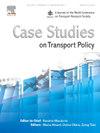Role of urban landscape in regulating e-rickshaw services: A case study of Krishnanagar Municipality, India
IF 3.3
Q3 TRANSPORTATION
引用次数: 0
Abstract
This study analyzes the development of e-rickshaw services in Krishnanagar Municipality, India, highlighting how the urban landscape shapes these services. The research employed a triangulation method to collect data, primarily analyzed using statistical techniques and Geographic Information System (GIS). The findings indicate that higher densities of Public Utility Centres (PUCs), high built-up areas, and better road accessibility correlate with increased e-rickshaw services. Contrary to existing literature that suggests paratransit options primarily serve the outskirts of cities; this study finds that e-rickshaws predominantly operate in the central areas of Krishnanagar. Interestingly, fares for longer trips to the outskirts are relatively low. However, e-rickshaw services are mainly restricted to major thoroughfares. The central part of the city predominantly relies on pre-negotiated fares between operators and users, which leads to an uneven distribution of e-rickshaw stands across the municipality. This uneven location of stands results in inequitable service provision. Additionally, e-rickshaws have not successfully served as a mode of first-and-last-mile connectivity, as door-to-door service is only available for reserved trips. This study emphasizes the importance of planning e-rickshaw services within the urban landscape to improve residents’ mobility equity. The insights gained can benefit planners and policymakers by enhancing urban public transport, ultimately contributing to sustainable urban development.
城市景观在管理电动三轮车服务中的作用:以印度克里希那纳加尔市为例
本研究分析了印度克里希那纳加尔市电动三轮车服务的发展,强调了城市景观如何影响这些服务。本研究采用三角测量法收集数据,主要利用统计技术和地理信息系统(GIS)进行分析。研究结果表明,公共事业中心(puc)密度的增加、建筑密集区的增加以及道路可达性的改善与电动三轮车服务的增加有关。与现有文献表明,辅助交通选择主要服务于城市的郊区相反;这项研究发现,电动人力车主要在克里希那那格尔的中心地区运营。有趣的是,到郊区的长途旅行票价相对较低。然而,电动黄包车服务主要局限于主要道路。城市的中心部分主要依赖于运营商和用户之间预先协商的价格,这导致整个城市的电动人力车站分布不均匀。这种摊位位置的不平衡导致了服务提供的不公平。此外,电动人力车还没有成功地成为第一英里和最后一英里连接的模式,因为门到门的服务只适用于预定的行程。本研究强调在城市景观中规划电动三轮车服务的重要性,以改善居民的出行公平。从中获得的见解可以通过加强城市公共交通使规划者和决策者受益,最终促进城市的可持续发展。
本文章由计算机程序翻译,如有差异,请以英文原文为准。
求助全文
约1分钟内获得全文
求助全文

 求助内容:
求助内容: 应助结果提醒方式:
应助结果提醒方式:


